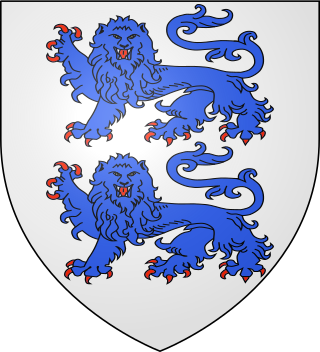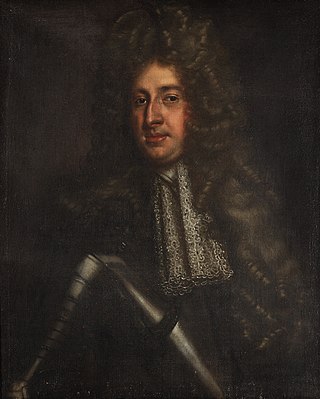
Lord Napier, of Merchistoun, is a title in the Peerage of Scotland. It was created in 1627 for Sir Archibald Napier, 1st Baronet. Earlier that year, he already held the Napier Baronetcy, of Merchistoun in the County of Midlothian, created in the Baronetage of Nova Scotia. The titles remained united until 1683, when the Baronetcy became dormant. It was revived in the early 19th century and is now held by another branch of the Napier family. Between 1683 and 1686, the Lords of Napier also held the Nicolson Baronetcy, of Carnock in the County of Stirling, and since 1725 the Scott Baronetcy, of Thirlestane in the County of Selkirk, both baronetcies created in the Baronetage of Nova Scotia. The latter one is held till today. Additionally, the tenth Lord was created Baron Ettrick, of Ettrick in the County of Selkirk in the Peerage of the United Kingdom on 16 July 1872.

Earl of Kimberley, of Kimberley in the County of Norfolk, is a title in the Peerage of the United Kingdom. It was created in 1866 for the prominent Liberal politician John Wodehouse, 3rd Baron Wodehouse. During his long political career, he notably held office as Lord Lieutenant of Ireland, Secretary of State for the Colonies, Secretary of State for India and Secretary of State for Foreign Affairs. He was succeeded by his son, the second Earl. At first a Liberal like his father, he later joined the Labour Party, becoming the first Labour member of the House of Lords. His eldest son, the third Earl, represented Norfolk Mid in the House of Commons as a Liberal. Since 2002, the titles are held by the latter's grandson, the fifth Earl.

Viscount Gage, of Castle Island in the County of Kerry of the Kingdom of Ireland, is a title in the Peerage of Ireland. It was created in 1720 for Thomas Gage, along with the subsidiary title of Baron Gage, of Castlebar in the County of Mayo, also in the Peerage of Ireland. In 1744 he also succeeded his cousin as eighth Baronet, of Firle Place. The titles remain united. The Gage family descends from John Gage, who was created a baronet, of Firle Place in the County of Sussex, in the Baronetage of England on 26 March 1622. His great-grandson, the seventh Baronet, represented Seaford in Parliament. He was succeeded by his first cousin, Thomas Gage, 1st Viscount Gage, the eighth Baronet. He sat as a Member of Parliament for Minehead and Tewkesbury and also served as Governor of Barbados. In 1720, 24 years before succeeding in the baronetcy, he was raised to the Peerage of Ireland as Baron Gage and Viscount Gage. His second son was the military commander the Hon. Thomas Gage.
Sir Thomas Gage, 7th Baronet, of Hengrave was an English botanist from Rokewode-Gage baronets. The woodland flower Gagea is named in his honour.

There have been two baronetcies created for members of the Hanmer family of Flintshire, Wales, one in the Baronetage of England and one in the Baronetage of Great Britain. Only one creation is extant as of 2008. The third Baronet of the second creation was elevated to the peerage as Baron Hanmer in 1872, a title which became extinct in 1881. The family name derived from the manor of Hanmer in the Diocese of St. Asaph.

Hengrave Hall is a Grade I listed Tudor manor house in Hengrave near Bury St. Edmunds in Suffolk, England and was the seat of the Kitson and Gage families 1525–1887. Both families were Roman Catholic recusants.
There have been two baronetcies created for persons with the surname Gage, both in the Baronetage of England. One creation is extant as of 2008.
There have been four baronetcies for persons with the surname Blake, one in the Baronetage of Ireland, two in the Baronetage of Great Britain and one in the Baronetage of the United Kingdom. Two of the creations are extant as of 2010. The Blake Baronetcy, of Menlough in the County of Galway, was created in the Baronetage of Ireland on 10 July 1622 for Valentine Blake, Mayor of Galway in 1611 and 1630 and a member of the Irish House of Commons for County Galway. His grandfather Thomas Blake had preceded him as Mayor. The second Baronet was a member of the Irish Parliament for Galway Borough. The third Baronet represented both County Galway and Galway Borough in Parliament. The sixth Baronet was a member of the Irish House of Commons for County Galway. He was the first Catholic gentlemen of distinction to join William of Orange. The twelfth Baronet represented Galway Borough in the British House of Commons. The fourteenth Baronet was high sheriff of County Galway in 1872. See also the Blake Baronetcy of Twizell Castle below.

William Herbert, 2nd Marquess of Powis DL was an English peer and Jacobite supporter.

Thomas Burgh, 1st Baron Burgh also spelt Borough, KG, 1st Baron Borough of Gainsborough, also de jure 5th Baron Strabolgi and 7th Baron Cobham of Sterborough, was an English peer. In 1513 he was knighted on Flodden Field, where he was one of the King's Spears, a bodyguard of King Henry VIII. He later became Lord Chamberlain to Anne Boleyn. He was also one of the twenty-six Peers summoned to the trial of Anne Boleyn in May 1536.

Firle Place is a Manor house in Firle, Sussex, United Kingdom. The Gage family have owned the land at Firle since acquiring it from the Levett family in the 15th century. The manor house was first built in the late 15th century by Sir John Gage, who made Firle Place his principal home. He held many high offices, including Constable of the Tower and was an executor of Henry VIII's will.
There have been four baronetcies created for persons with the surname Musgrave, one in the Baronetage of England, one in the Baronetage of Nova Scotia, one in the Baronetage of Ireland and one in the Baronetage of the United Kingdom. As of 2014 two of the creations are extant.

The Winnington Baronetcy, of Stanford Court in the County of Worcester, is a title in the Baronetage of Great Britain.

The Craufurd Baronetcy, of Kilbirney in south-west Scotland, is a title in the Baronetage of Great Britain. It was created on 8 June 1781 for Alexander Craufurd, the member of an ancient Scottish family. The General and Major-General were elected to the Nottinghamshire East Retford of the almost wholly unreformed (pre-1832) House of Commons.

The Sebright Baronetcy, of Besford in the County of Worcester, is a title in the Baronetage of England. It was created on 20 December 1626 for Edward Sebright, High Sheriff of Worcestershire who later fought as a Royalist in the Civil War. He was the son of John Sebright of Blakeshall, Wolverley and was the heir of his uncle William Sebright (1541–1620) of Besford, who established by his will in 1620 the charity "Sebright's Endowed Schools", still surviving today and very richly endowed as "Sebright's Educational Foundation". The fourth Baronet sat as Member of Parliament for Hertfordshire. The sixth Baronet represented Bath in the House of Commons. The seventh Baronet was Member of Parliament for Hertfordshire and also became known as an agriculturalist. The family's fortunes ebbed by the end of the nineteenth century, with the ninth Baronet leaving only £5 at his death. The current baronet is Sir Rufus Hugo Giles Sebright, born 1978 in Nîmes, France.
John Gage was a partner at Kleiner Perkins and the former Vice President of the Science Office at Sun Microsystems.
Sir John Gage, 1st Baronet was an English baronet and landowner, and ancestor of the Viscounts Gage.
Sir Edward Gage, 1st Baronet was an English baronet.

Mary Herbert, Marchioness of Powis, was the wife of William Herbert, 2nd Marquess of Powis and the mother of William Herbert, 3rd Marquess of Powis.












